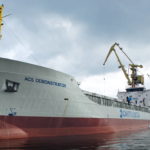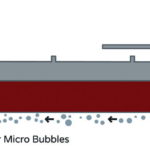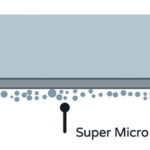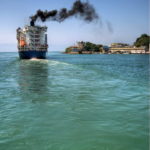Air lubrication systems are a credible technology for ships saving fuel, and therefore costs and greenhouse gas emissions. Noah Silberschmidt from DK Group describes the impact on the global fleet
Shipping’s perspective on clean technology is undergoing a sea change as the industry begins to adopt innovative solutions, driven[ds_preview] by high fuel prices, impending regulation and ongoing commercial pressures to increase efficiency and reduce operational costs. This shift in perception reflects the attitude that sustainability is gradually becoming accepted as a business imperative rather than just a brand-driven luxury. As this behavioural change continues, so the opportunities and benefits that can be delivered by clean technology will grow alongside it.
Of all the clean technology options, there is a growing awareness in the industry that it is air lubrication that delivers on its fuel-saving promises and can make a significant positive impact on commercial operations, emissions reduction and both the existing and future fleet. As a result, air lubrication providers are continuing to innovate and demonstrate tangible results, both in test facilities and increasingly on board ocean-going vessels.
There are several solutions being offered in varying stages of testing and development and that claim varying degrees of fuel and emissions savings, but trialling the technologies and seeing demonstrable results based on commercial vessels in real-life operations is crucial to greater take-up.
DK Group’s patented air lubrication technology, the Air Cavity System (ACS), has been shown to deliver fuel savings and therefore emissions reduction of up to 10 %, dependent on vessel size and type. ACS is designed to lubricate the flat bottom area of ships and uses air bubbles on the boundary layer of the vessel, thus reducing frictional resistance between the water and the hull surface. It is engineered to place the bubble generator under the ship, enabling the technology to create and maintain a rigid bubble carpet that is more realistic and organic. Air cavities (chambers) are arranged at the front of the bottom of the vessel. The chambers are then filled with air. The bubbles created have a specific structure and are then carried past the chamber and into the boundary layer of the vessel. This significantly reduces propulsion power demand and fuel consumption, and results in reduced greenhouse gas (GHG) emissions.
The size, geometry and number of cavities required depend on the size and type of the vessel. Each cavity has its own independent compressor, pipe and control system. The process is controlled by DK Group’s patented software. Sensors inside the chambers monitor the surface and relay information back to the air system on the amount of air needed.
The investment payback period for retrofit will range between 18 months and three years, and on a new build this payback period reduces to around six months. Downtime is minimal and no specialist ship equipment is required, making this a relatively simple procedure for most shipbuilding and repair yards. The ease of installation is a critical factor in the mass adoption of any technology, and the low order complexity of ACS means that installation is scalable in line with the growing demands of shipowners looking to comply with incoming emissions reduction regulation, as well as capture crucial fuel savings.
ACS as retrofit
There is only a small group of solutions in the market that can deliver double-digit fuel savings dependent on vessel size. When such significant results are claimed, it is vital that they are substantiated with credible and empirical evidence. This is particularly important given the reported threat of a two-tier market, which is driving shipowners to consider scrapping ships. However, this does not need to become a self-fulfilling prophecy, as there are credible solutions available now which negate this situation. The choice is simply not new build vessels or scrap; there is an available alternative – retrofit technology.
Retrofit represents a significant opportunity for all shipowners to access the commercial benefits of clean technology. Within air lubrication, DK Group’s ACS is avail-able as a retrofit option as well as for newbuild vessels. The structural design impact of ACS on the hull is minimal and non-invasive, and can be compared to keyhole surgery for a vessel – there is very little downtime and maintenance needed. Given cur-rent concerns regarding a potential two-tier market, ACS Retrofit can extend the lifetime of a vessel, therefore reducing the need to purchase new build vessels and maximising the potential of the existing fleet.
As pioneers of retrofit air lubrication solutions, DK Group is solely focused on enhancing its technology further, which is driven by investment in a comprehensive and ongoing R&D programme. Working closely with hydrodynamic testing and research facility HSVA (Hamburgische Schiffbau-Versuchsanstalt) and classification society Germanischer Lloyd, DK Group has conducted 29 separate weeks of tests with ACS since its inception.
During the last two years DK Group and HSVA have worked together to test a full scale ACS, specifically to improve the cavity geometry to increase the power savings as well as the cavity stability for automating onboard operations. Testing spanned more than six weeks and explored different cavities and conditions. This included varying ship draughts and airflow rates. The total and the local friction forces, the injected airflow rate, the water speed and the tunnel pressure were measured continuously, whilst the cavity stability, the bubble tail behaviour and the bubble size distribution were documented and analyzed.
Air lubrication is an active system that requires power to provide compressed air and for injection of a certain airflow rate to the areas to be lubricated. Test results therefore accounted for this power balance of the tested ACS model.
The results of these tests have led to the impending installation of ACS technology on a 12,580 dwt multi-purpose vessel owned by Danish shipowner and ship management company Dannebrog Group which is due in the fourth quarter of 2012. The sea trials will again be conducted by HSVA and overseen by Germanischer Lloyd both prior to and after the conversion to establish and benchmark relative fuel consumption and the associated emission profile.
Naturally the cost and exact saving depends on the individual vessel and if ACS is planned for and installed as part of a new vessel design. However, as an example, applying ACS Retrofit to a VLCC would bring a payback period of two years. For container ships, payback time is typically below two years. As impending environmental legislation drives shipowners to use significantly more expensive distillate products as of 2015, retrofit and newbuild payback periods will reduce further.
As shipping embarks upon an exciting and challenging new era of technological development, it will be innovative technologies that combine cost savings with reduced emissions that will lead the way. Proven air lubrication technologies such as ACS open the door to cost savings, emissions reduction and an enhanced competitive advantage at a time when shipping is undergoing significant change. Air lubrication is one of the most advanced of a new breed of clean technologies that will play a fundamental role in shipping’s future as environment regulations grow and the industry commits to a more sustainable future.
Author:
Noah Silberschmidt
Managing Director, DK Group
noah.silberschmidt@dkgroup.eu
Noah Silberschmidt



















